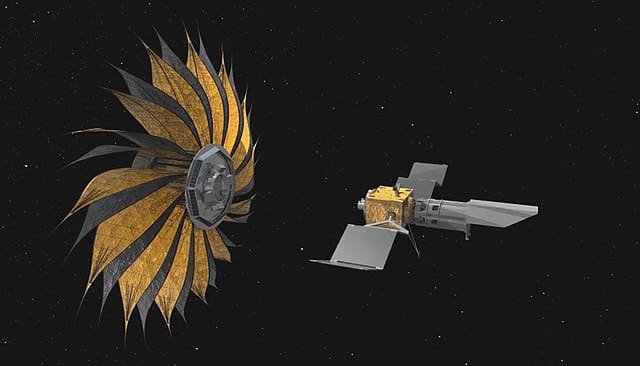Unveiling Earth-like planets with flower starshade technology is an innovative approach to finding and characterizing exoplanets in other star systems. The starshade, often referred to as a “flower” due to its petal-like design, is a cutting-edge instrument concept designed to block out the light from a host star, allowing for direct observation of orbiting exoplanets. Here’s how this technology works and the steps involved in its implementation:
1. Starshade Design:
- Develop a starshade with a large, precisely-shaped structure, typically with multiple petals that can be unfurled in space.
- Each petal is designed to block the light from a star while allowing the light from orbiting exoplanets to pass through.

2. Space Telescope Integration:
- Launch a space telescope into orbit with a starshade-equipped payload.
- The telescope and starshade work in tandem to observe exoplanetary systems.
3. Precise Formation Flying:
- Achieve and maintain precise alignment and formation flying between the starshade and the telescope. This requires advanced control systems and navigation techniques.
4. Starlight Suppression:
- Position the starshade between the telescope and the target star, blocking its light.
- This enables the telescope to observe exoplanets with much greater sensitivity and detail, as the overwhelming starlight is suppressed.
5. Exoplanet Detection and Characterization:
- Capture images or spectra of exoplanets orbiting the target star, allowing scientists to study their properties, such as composition, temperature, and potential habitability.
6. Data Analysis:
- Analyze the data collected by the telescope and starshade to identify and characterize exoplanets.
- Determine key parameters, such as the exoplanets’ orbits, sizes, atmospheres, and potential signs of habitability.
7. Public Outreach and Education:
- Share mission updates and discoveries with the public, students, and the scientific community to generate interest in exoplanet research and space exploration.
8. International Collaboration:
- Collaborate with other space agencies, research institutions, and international partners to share data, expertise, and resources.
9. Ethical Considerations:
- Consider the ethical and environmental implications of any discoveries made during the mission, especially if signs of potential habitability or life are detected.
10. Future Missions:
- Continue to develop and launch starshade-equipped telescopes for studying more exoplanetary systems, potentially identifying Earth-like planets with the potential for life.
The flower starshade technology is an exciting development in the field of exoplanet research, as it allows for the direct observation and characterization of distant worlds. It has the potential to uncover Earth-like planets in the habitable zones of other stars, advancing our understanding of the possibilities for life beyond our solar system.











